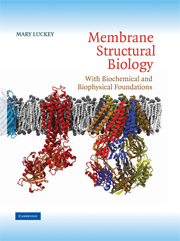Book contents
- Frontmatter
- Contents
- Preface
- 1 Introduction
- 2 The Diversity of Membrane Lipids
- 3 Tools for Studying Membrane Components: Detergents and Model Systems
- 4 Proteins in or at the Bilayer
- 5 Bundles and Barrels
- 6 Functions and Families
- 7 Protein Folding and Biogenesis
- 8 Diffraction and Simulation
- 9 Membrane Enzymes and Transducers
- 10 Transporters and Channels
- 11 Membrane Protein Assemblies
- 12 Themes and Future Directions
- Appendix I Abbreviations
- Appendix II Single-Letter Codes for Amino Acids
- Index
- References
10 - Transporters and Channels
- Frontmatter
- Contents
- Preface
- 1 Introduction
- 2 The Diversity of Membrane Lipids
- 3 Tools for Studying Membrane Components: Detergents and Model Systems
- 4 Proteins in or at the Bilayer
- 5 Bundles and Barrels
- 6 Functions and Families
- 7 Protein Folding and Biogenesis
- 8 Diffraction and Simulation
- 9 Membrane Enzymes and Transducers
- 10 Transporters and Channels
- 11 Membrane Protein Assemblies
- 12 Themes and Future Directions
- Appendix I Abbreviations
- Appendix II Single-Letter Codes for Amino Acids
- Index
- References
Summary
For most of the past century, transporters and ion channels have been the object of many physiological, genetic, biochemical, biophysical, and bioinformatic investigations that have provided a wealth of data about how molecules and ions cross biological membranes (see Chapter 6). In recent years they have also become the subject of structural biology, as a few high-resolution structures have added details from a rich vein of structure–function relationships. The award of the 2003 Nobel Prize to Peter Agre and Rod McKinnon for the x-ray structures of aquaporin (AQP) and the potassium channel brought wide attention to the progress in this field. This chapter presents examples that have varied histories, from the long-studied lactose permease encoded by the lacY gene in the lac operon to a relative newcomer, the water channel AQP.
TRANSPORTERS
Transport proteins are required for all cells to take up nutrients and to dispose of waste materials, as well as to mediate flux of metabolites between intracellular compartments of eukaryotes. In the cell envelope of Gram-negative bacteria, transport across the outer membrane is facilitated by porins that contain water-filled channels with varying specificity for solutes (see “Porins” in Chapter 5). In contrast, transport proteins of the inner membrane tend to be highly specific for their substrates, and consequently the cell has many diverse transporters in this membrane. Lactose permease and the glucose-3-phosphate transporter of E. coli are examples of specific inner membrane transport proteins, both of whose x-ray crystal structures were reported in 2003.
- Type
- Chapter
- Information
- Membrane Structural BiologyWith Biochemical and Biophysical Foundations, pp. 241 - 270Publisher: Cambridge University PressPrint publication year: 2008



